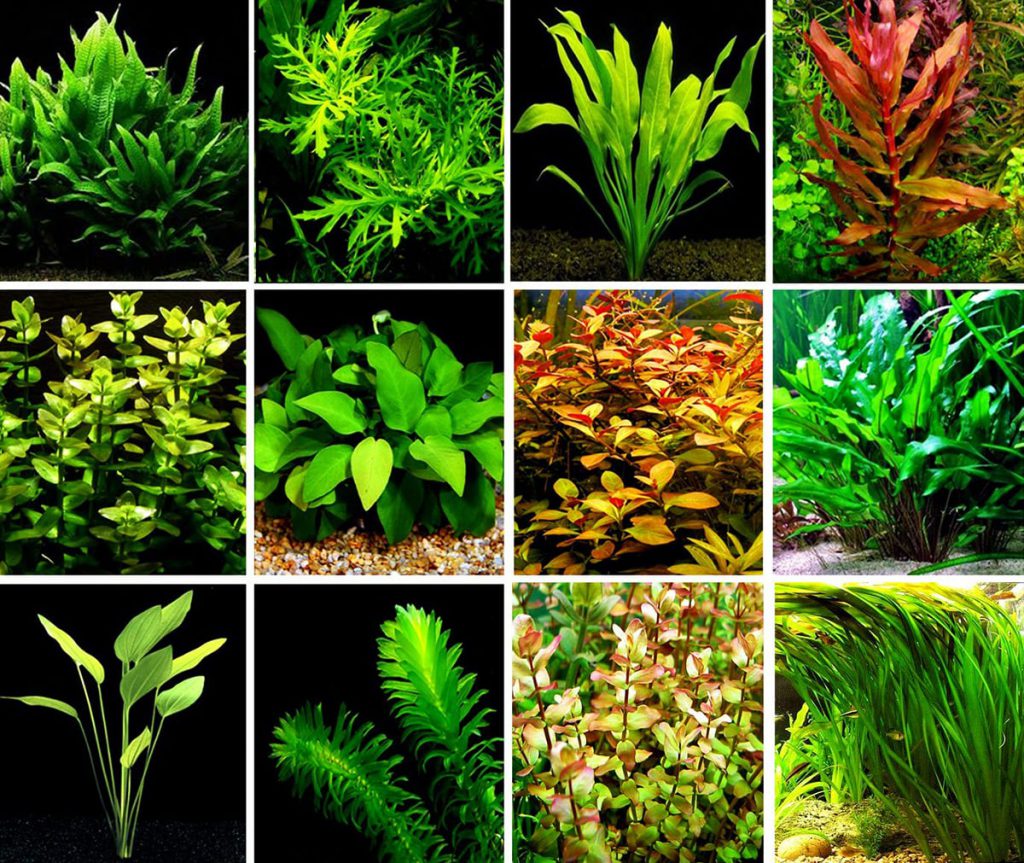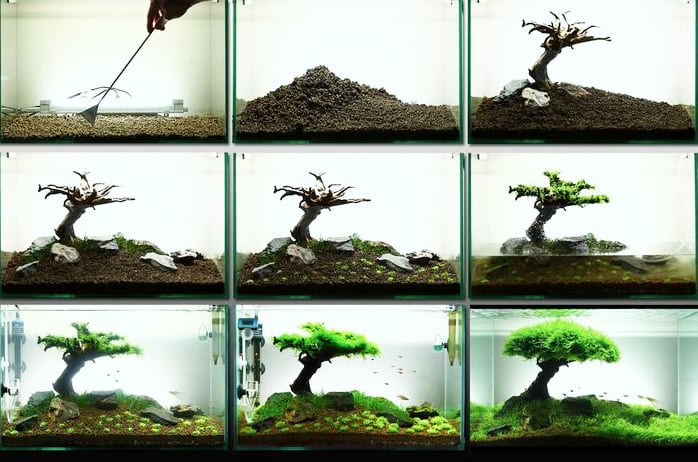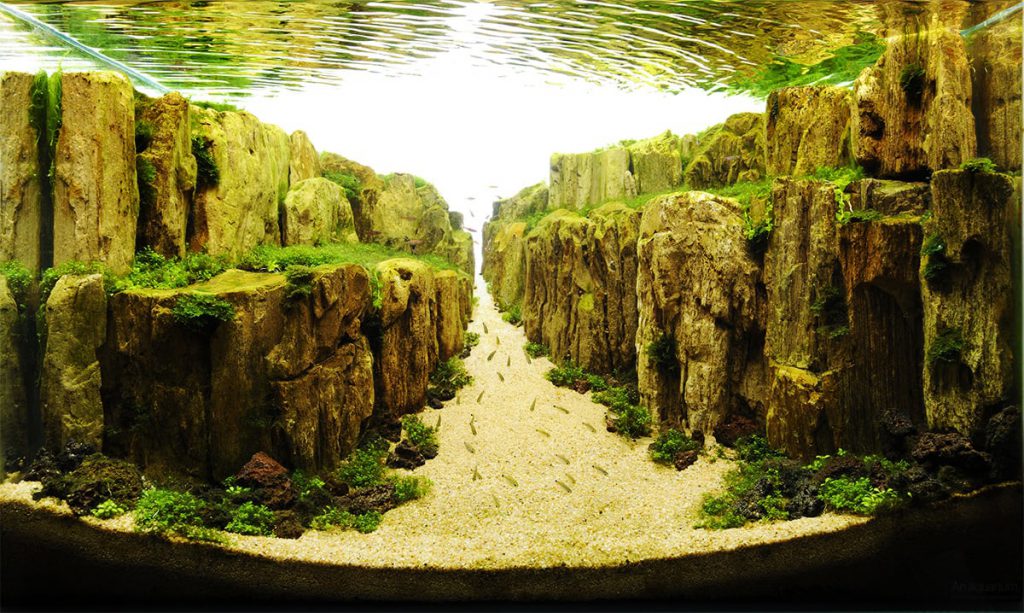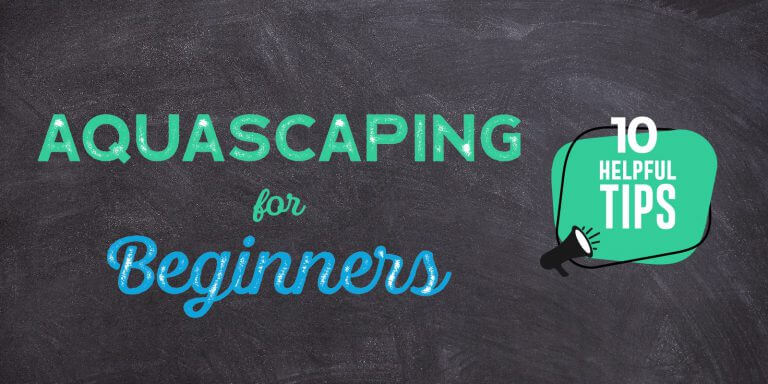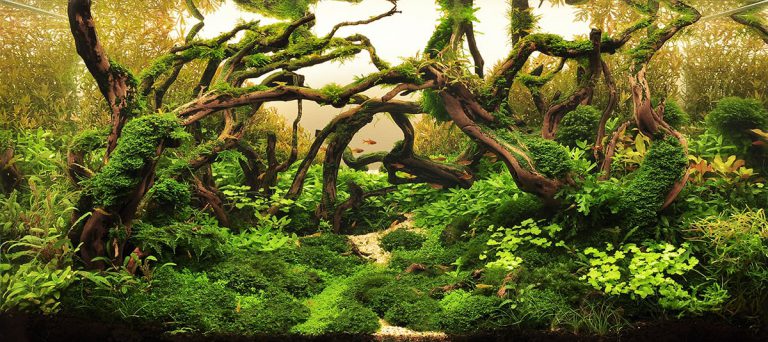Aquascaping is an art form like no other. It is the considered placement of rocks, stones, and driftwood inside an aquarium to create an aesthetically pleasing display. Inspiration can come from anywhere, from other aquascapes to luscious forests, waterfalls and beaches. When you start your very first aquascape, you are creating a unique work of art under water.
While challenging, creating your first aquascape as a beginner, can be a lot of fun. By following a few basic principles and tips, you can create a solid base for a fantastic design.
Many people find that the process of aquascaping is a continuous process rather than a one-off piece. A top aquascaping tip is to look at as many different designs and styles as you can, and from all angles. Make notes about what parts of the designs appeal to you and the layouts that you would love to recreate.
Three people who are award-winners in the aquascaping world are:
- Takashi Amano
- James Findley
- George Farmer
If you are creating your first aquascape, you can’t go far wrong by having a good look at the work completed by these three. Their tips and examples will aid you on your way to creating a superior aquascape that will allow you to have an aquatic paradise in the comfort of your own home.
Here Are Our Top 9 Aquascaping Tips For Creating Your First Stunning Planted Tank
1. The Rule of Thirds
Nobody knows quite why, but the human eye finds a scene the most pleasing when the main focal point and regions are aligned along three vertically and horizontally lines.
Somehow the rigidity of maths can be applied to art! The ‘Rule of Thirds’ is all about creating an aesthetically pleasing outcome. Does this mean that you need to perfectly align everything in your aquascape? Not completely, but it’s a great guideline to work with.
Aquascaping tip: Think about your focal point. One of the great ways to use the Rule of Thirds is to create movement, and what better place than a living, breathing aquarium to create this.
If you have water moving faster on the left hand side of your aquarium, for example, then positioning one of the main features of your aquascape one third to the left will draw the eye towards that focal point and create a moving story in your aquarium.
2. Focal Points
Focal points are generally created with the use of effective plant selection, considering colours and textures. Having an area or a main feature will help you to prevent your aquascape from being overly busy or distracting.
Aquascaping tip: The old adage of ‘less is more’ is generally a great tip! In the aquascaping style known as Iwagumi, works with the Rule of Thirds to create its beautiful designs and focal points. This style uses stones placed in particular patterns and uses the central stone as its focal point, placed on one of the imaginary lines of the Rule of Thirds.
Sometimes a packed aquarium can look great, but really consider the effect you are working to create.
3. Planting – Foreground, Middle and Background Features
One of the most common aims of the beginning aquascaper is to create a carpeted tank. This produces a beautiful effect and can form the base for some stunning creations.
Possibly the most important aspect to get right when choosing the plants for your tank is to understand plant conditions. Without the right amount of CO2, light and fertilisers, your plants simply won’t grow. Research, research, research, and you will be able to create the green carpet you are looking for.
Now you can start to think about the layout of your aquascape. Start at the back and work forwards. A great aquascaping tip here is to really make sure these areas are distinguished.
It’s not just plants that are used in aquascaping; rocks and driftwood make great middle ground features. Consider the long borders of (land) gardens at stately homes and how aesthetically pleasing they are. A lot of time, effort and planning goes into achieving successful borders and this must be the way you approach your aquascape.
Aquascaping tip: If you are planning this design as a long-term project, then space the stems out. For an instant wow factor, plant stems densely.
4. Aquarium Plant Selection
Correct plant selection and placement will make for an attractive aquascape. Not only that, but they will contribute to the water quality and pH balance of your aquarium.
Whether you want to create a wild and stormy aquascape or a calm and peaceful display, there is a wide range of plants that can be used to create your ideal display.
When you choose plants in your local shop, do remember that they can look very different as mature plants! If you have chosen a plant for a colour scheme this is particularly important. Just because you have bought a small plant, does not mean that it will stay small.
Aquascaping tip: Make sure you know how tall it will grow (if you are designing a long-term aquascape) and plant it accordingly.
5. Symmetry
There is not a ‘maybe’ response here. In an aquascape, symmetry is simply not desirable. While the Rule of Thirds is pleasing to the eye, symmetry just looks too controlled.
Aquascaping tip: When a plant or other focal point is placed right in the middle or two identical plants at the edges of the aquarium, the end result is a symmetrical and aesthetically unbalanced aquascape.
6. Scale
Having the scale spot-on in your aquascape will make the difference between a good display and a great display that will take your breath away. Substrate size makes a huge difference to the look and ‘feel’ of your display.
Professional aquascapers are all choosing to use the ADA powder type of topsoil in their aquascapes. This type of substrate has a really fine grain size making it perfect for the smaller aquascapes, as well as enabling a greater sense of scale. This is the perfect substrate if you are trying to create scale in a ‘Miniature Garden’ style aquascape.
Another really important area to consider when planning your aquascape is the middleground. You’ve carefully planned the substrate, topsoil, background planting, but what about the void in the middle of the aquarium?
This is a brilliant opportunity to use one stunning piece for the focal point – why not stand a stone vertically instead of horizontally? It’s important to incorporate smaller stones as well as larger stones into your aquascape.
Think about how stones would stand in nature; very rarely are large stones just sitting there by themselves. There are always smaller stones around them, even parts that have been chipped from the bigger stones. Stones in nature are seldom perfectly round or textured.
Aquascaping tip: To create a natural scene, consider choosing the less than perfect items.
7. Contrast
Contrast is one of the really tricky parts to get just right. Subtle changes to your design are what will really show off expertise in your understanding of aquascaping design.
Aquascaping tip: The simplest way to get this right, or at least being on the right path, is to choose two plants with different qualities, and simple substrates and hardscapes.
This way of keeping the variation down will allow the specialised items you have chosen to shine. A busy aquarium is a confusing aquarium.
8. ‘Green Box’ Aquascaping
Unfortunately, the choices of plants available in mainstream shops for aquascaping are in multiple shades of green. While plants do need to be green to photosynthesise, your aquascape does not have to be a green box!
Aquascaping tip: Taking this into consideration, choose your plants wisely and use other features such as substrate and hardscaping to accentuate the areas of your design you want to make the focal point.
9. … and Finally – Fish!
Beginning your aquascaping journey is exciting. You might start with a clear vision of what fish you would like to keep, or the aquascape you would like to create.
These two areas have to come together otherwise your aquascape just won’t look right or survive. When choosing fish, keep focused on your end plan for your aquascape. If you want to keep more than one species, make sure you have checked that they will live side-by-side in peace.
Aquascaping tip: Remember that fish grow! If you are buying a juvenile of a species make sure you know its estimated size as an adult and that you will still be able to house it.
As with so much in life, Anything worth doing, is worth doing right (Hunter S. Thompson). Creating your own, unique work of art under water is a challenging but very rewarding process.
Take your time when making decisions and carry out as much research as possible. Remember also that the aquascape that you create does not have to be a final piece. Once you have entered the world of aquascaping, there will always be new ideas that will inspire you.
Anything worth doing, is worth doing right.
Hunter S. Thompson
Keep an eye on the displays other enthusiasts are creating as well as the professionals. Following the tips we have suggested above will, we hope, ensure that your creation is an aquatic paradise that you will be proud of and will really enjoy in your home.





